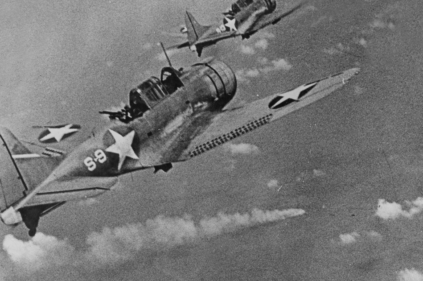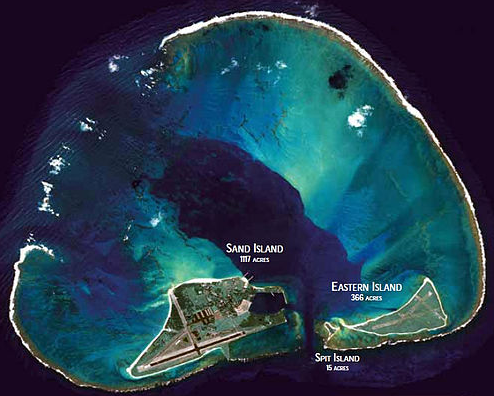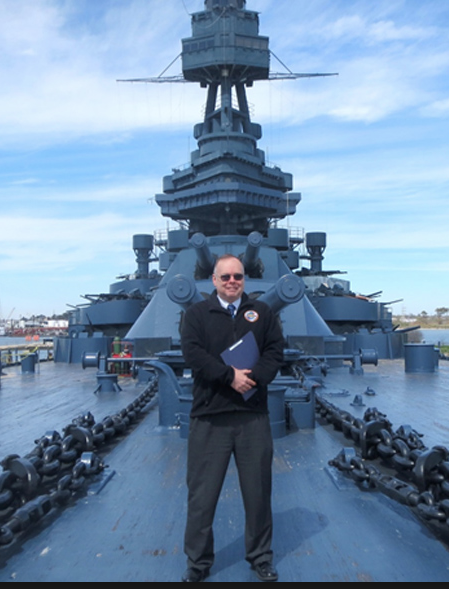
Gentle Readers,
You noted our commemoration of the 75th Anniversary of the great conflict off Midway Atoll 75 years ago. It was at the beginning of the month of June, on the actual days that defined history. Today, the last remnants of the battle were being resolved though the memories will never fade. The Japanese were retreating west. The damaged USN ships were returning for repair and replenishment at Pearl.
The party at Joe Rochefort’s quarters for the code-breakers was wrapped up after three days of celebration, and the partiers had gone back to work in the Dungeon, 24×7, to continue the effort to defeat the Empire of the Sun. But a quarter century ago, something fundamental had changed on this Father’s Day.
I will let this account stand as the one that defines the struggle, delivered at the very place at the focus of those climactic events. Retired RADM Sam Cox, current curator of all the U.S. Navy’s history, memorabilia and wreckage strewn across this wide and verdant world delivered this memorial to those who fought, died and won on the very sands that were the focus of the most titanic Naval battle since Trafalgar.
Sam notes:
“It was a career highlight. Deeply moving to have been on Midway Island, and to finally actually get in the basement at HYPO (seen the outside door a bunch of times before.) Here is the piece that I wrote on Intelligence, Surveillance and Reconnaissance (ISR) at Midway that went to all flag officers, plus the CNO’s Midway speech.
The link to the Chief of Naval Operations speech is at:
http://www.navy.mil/navydata/people/cno/Richardson/Speech/CNO_RemarksBattleofMidwayCommemoration.pdf>
www.navy.mil
“Here is the text of my address on Midway Island, delivered at 0700 Monday, 5 Jun, 2017”:
 or of speaking here.”
or of speaking here.”
“75 years ago at this time (yesterday) this island had just been attacked by 108 planes from four aircraft carriers of the Imperial Japanese Navy. On a six month victory spree, the Japanese expected to catch Midway by surprise. Instead, they were surprised to find 3,000 heavily entrenched and fortified United States Marines, who had made a pact amongst themselves, that no matter what happened, at Midway there would be no surrender. The Japanese were also surprised to find Midway reinforced with aircraft, 127 total, and every plane that was flyable was already airborne, thanks to early warning provided by Navy PBY Catalina flying boats flying from this lagoon, and which had already found the Japanese carriers. One of the Catalinas had already damaged a Japanese tanker with a torpedo on a daring night strike, the first hit of the battle by either side. Despite being heavily outclassed by the technologically superior Japanese “Zero” fighter planes, the Marine fighters defending Midway did not hesitate to attack the inbound Japanese airstrike, shooting down several aircraft before the Zeroes turned the tables and shot down most of the Marine fighters, of 28, only two returned to Midway in flyable condition.”
“But between the Marine fighters and the intense anti-aircraft fire put up by the Marine defenders on the island, almost half the Japanese planes were hit. Eleven were shot down and 14 seriously damaged. The loss of these aircraft would have a profound effect later in the battle when the Japanese launched their last-ditch strike against the American aircraft carriers, instead of having 18 torpedo bombers left on the carrier Hiryu, there were only ten. And had the US carrier Yorktown taken one more torpedo hit than she did, she almost certainly would have gone down in minutes, with much of her crew, rather than staying afloat for two days, and U.S. casualties might have topped a thousand.”
“Also at this time (shortly after 0700,) the first American strike aircraft from Midway Island had reached the Japanese carriers. Six navy TBF torpedo bombers and four US Army Air Force B-26 bombers carrying a torpedo each commenced their attack, and ran into 30 Japanese Zero fighters. Yet, the American planes did not turn away. In fact the Japanese had not encountered these new types of American aircraft and they proved incredibly difficult to shoot down, and the first planes shot down were two Japanese Zeros by defensive fire from the American planes.”
“Increasingly desperate to knock down the American planes, the Japanese fighters had to fly into the anti-aircraft fire from their own escort ships to do it. Two of the TBF’s got close enough to launch torpedoes against the Japanese carrier Hiryu, which out-maneuvered them, and one heavily damaged TBF launched a torpedo at the light cruiser Nagara, which missed. Only one of the six TBF’s made it back to a crash landing on Midway Island. Of the B-26’s, one was shot down, and two dropped their torpedoes at the Japanese flagship, the carrier Akagi, which avoided them. But the second B-26 buzzed the Akagi and shot up her flight deck with machine gun fire.”
The third B-26, whether uncontrollable or whether the pilot deliberately tried to crash into the Akagi with his crippled aircraft is unknown, but the B-26 missed the Akagi’s bridge by a matter of feet, almost killing Vice Admiral Nagumo and his staff. Two of the heavily-damaged B-26’s crash-landed on Midway.
“However, it was the extraordinary valor of the TBF and B-26 crews, and the anti-aircraft defenses at Midway, that convinced Admiral Nagumo that Midway Island was a very real and serious threat that had to be dealt with immediately, setting in motion a chain of decisions that would lead to disaster for the Japanese. Because, what Nagumo did not know, was that at this very hour, 117 aircraft from the U.S. carriers Enterprise and Hornet were already launching to attack him, and 35 more from the Yorktown would launch soon after.”
“About an hour after the first attack, 27 US Marine Corps dive-bombers from Midway Island reached the Japanese carriers, and they too suffered very heavy casualties, almost half were shot down, and despite numerous near misses no Japanese ship was hit. As it happened, the torpedo bombers from the three U.S. carriers then reached the Japanese carriers in successive waves, and of those 41 aircraft, only six returned to their carriers, and none of their weapons hit a Japanese ship.
The sacrifice of the torpedo bombers and the planes from Midway was not part of the plan, but was the result of the fortunes of war. What they did, however, was to keep the Japanese from getting their counterstrike airborne before, at 1020, 48 U.S. navy dive bombers appeared over the Japanese carriers and in the course of five minutes changed the course of the war, and of the history of the world.”
“The biggest mistake the Japanese made was reflected in their own operations order for Midway, specifically the statement that “the enemy lacks the will to fight.”
“The Japanese could not have been more wrong. After the humiliation of Pearl Harbor, not only was the “enemy” – the men on Midway and the ships nearby – willing to fight, but they were willing to press home their attacks in the face of overwhelming odds and even in spite of staggering losses.”
“Every U.S. bomber that found the Japanese either dropped their bomb or torpedo on target, or were shot down trying. Although many bombs and all the torpedoes missed, not one U.S. strike aircraft is known to have turned away in the face of the most intense Japanese opposition.”
Somewhat surprisingly, there was only one Medal of Honor awarded for the battle, posthumously, to Captain Richard Fleming, USMC, flying from Midway Island, for pressing home his attack on a Japanese heavy cruiser on the 5th of June.
“However, over 200 Navy Crosses were awarded to Navy and Marine Corps personnel, most to aviators, many posthumously, an extraordinary record of bravery and sacrifice under fire for which our nation should be eternally grateful, and which should never be forgotten. In honor of those who made the ultimate sacrifice, our Midway veterans, COL John Miniclier, USMC (Ret) and SGT Ed Fox, USMC (Ret) will now lay a wreath at this memorial.”
“Honor guard, post. ”
Hand salute.
(Wreath Laying)
“Taps.”
“Ready, two.”
“Ladies and gentlemen, we commemorate this battle.”
“We do not celebrate it. Over three thousand Japanese sailors lost their lives. And although we were bitter enemies at the time, for many years now Japan has been a very close friend and ally. The official tally for the U.S. was 307 deaths, however we do not know how many more perished months or even years later from their wounds or the effects of traumatic stress.”
“307 lives may seem like a reasonable price to pay for a victory of this magnitude, but that certainly was not the case for their families and loved ones. So I would ask everyone to join me in a moment of silence, followed by a singing of the Navy Hymn Eternal Father, in memory of all those who suffered as a result of this battle.” (silence).
“Thank you.”
“Eternal Father, strong to save,
Whose arm hath bound the restless wave,
Who bidd’st the mighty ocean deep
Its own appointed limits keep;
Oh, hear us when we cry to Thee,
For those in peril on the sea!”
Samuel J. Cox
RADM, USN (Retired)
Director of Naval History
Curator of the Navy
Director, Naval History and Heritage Command

